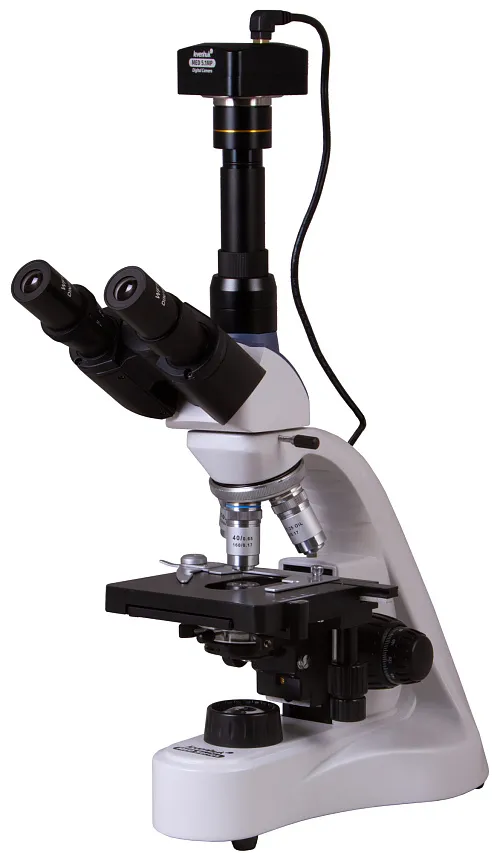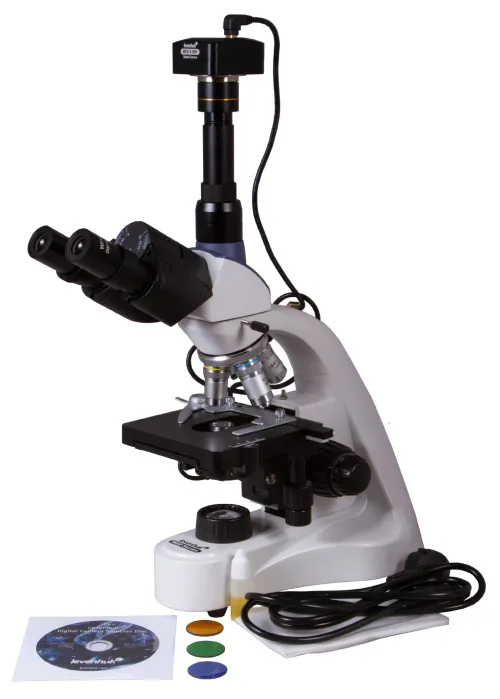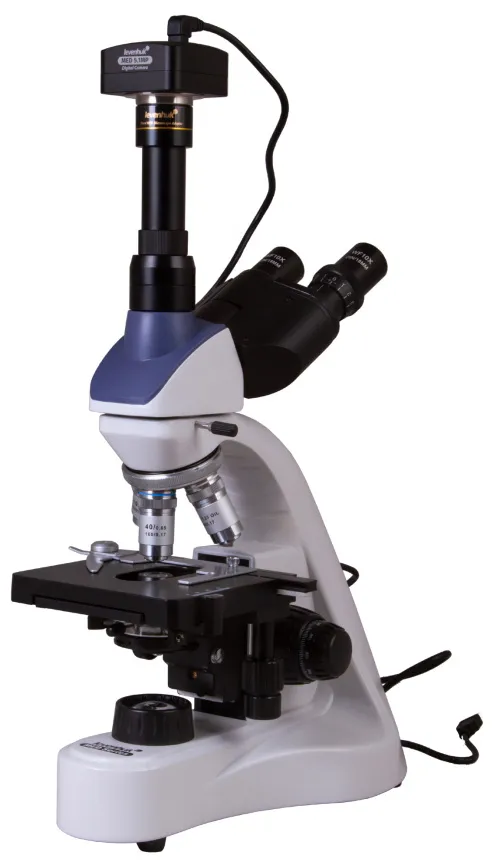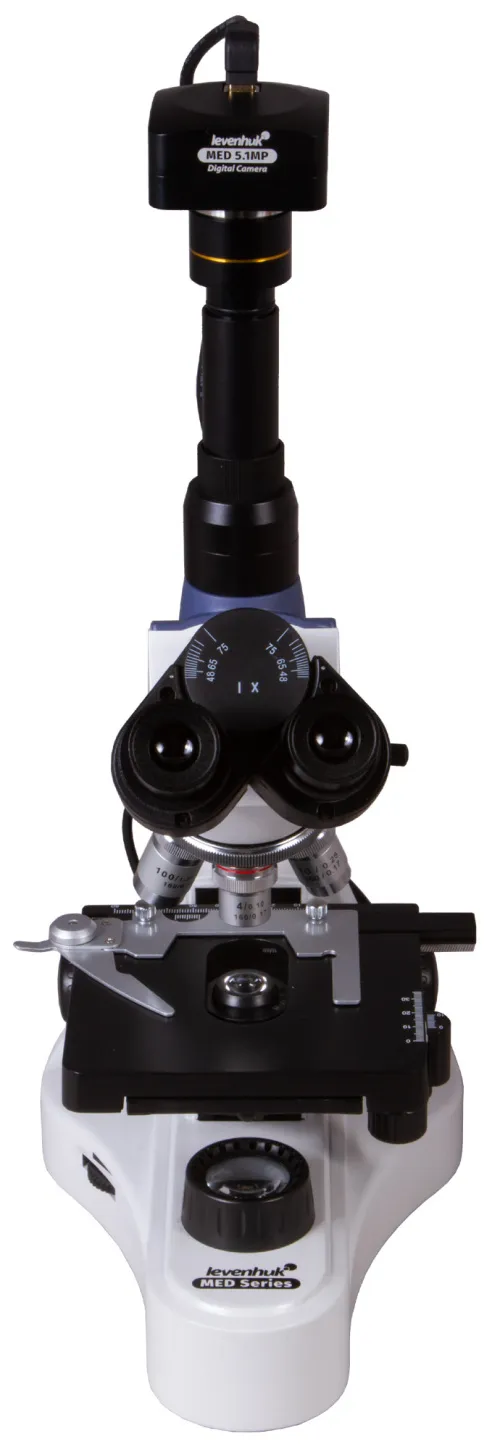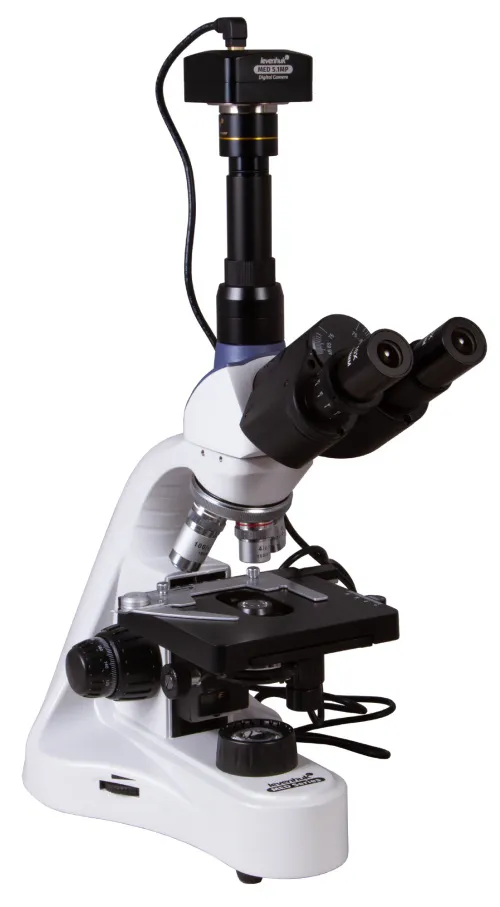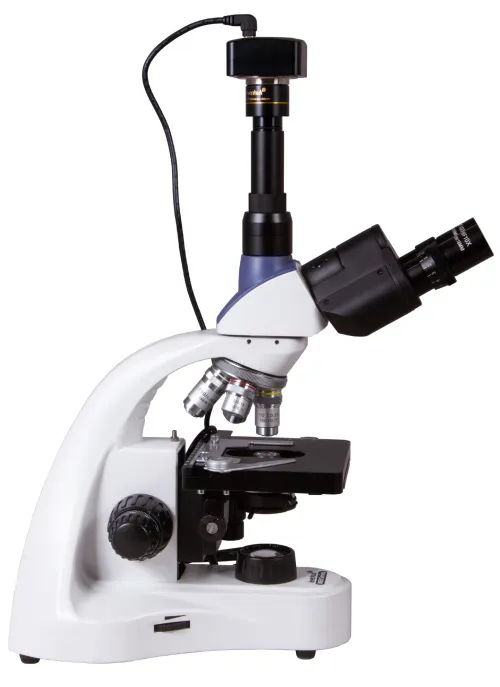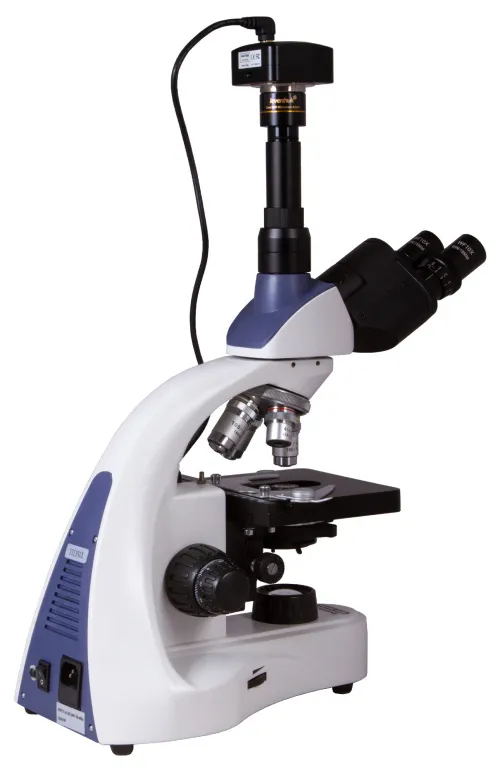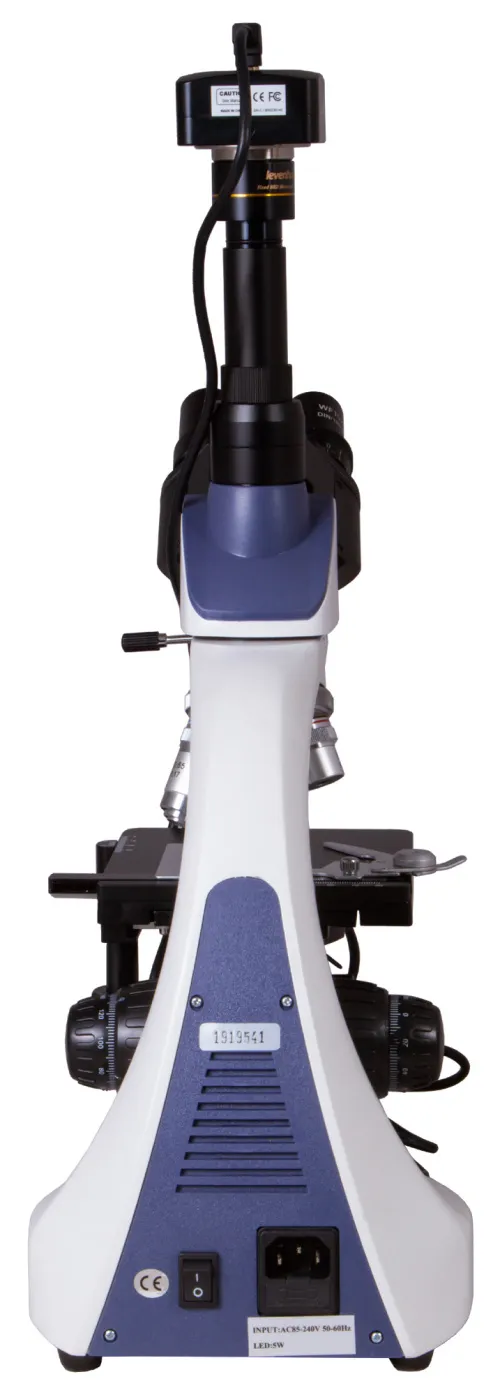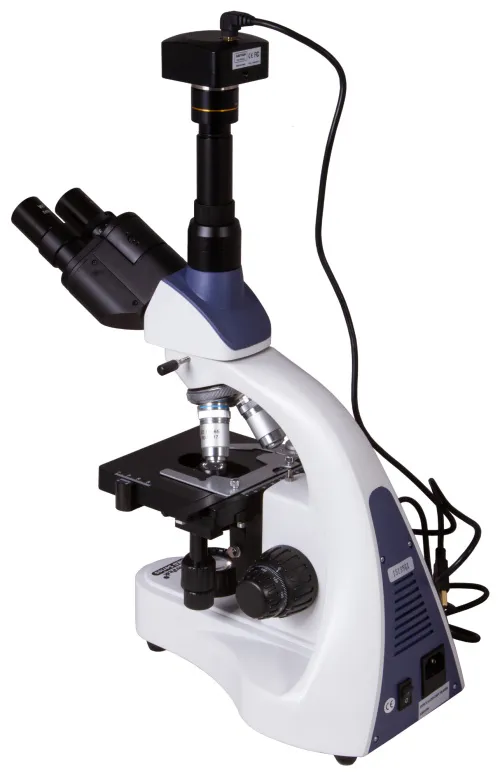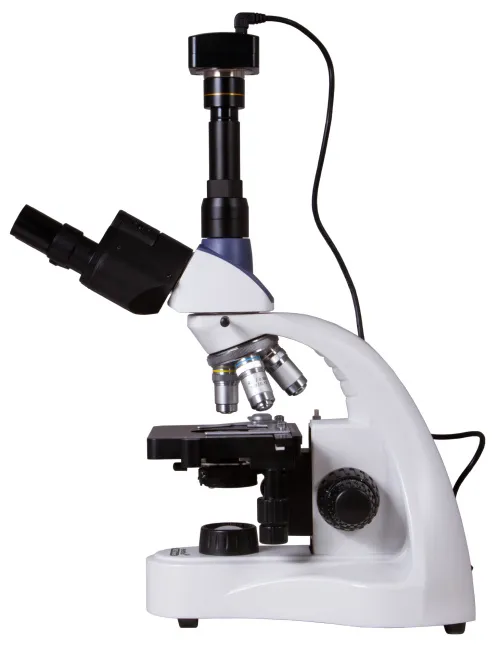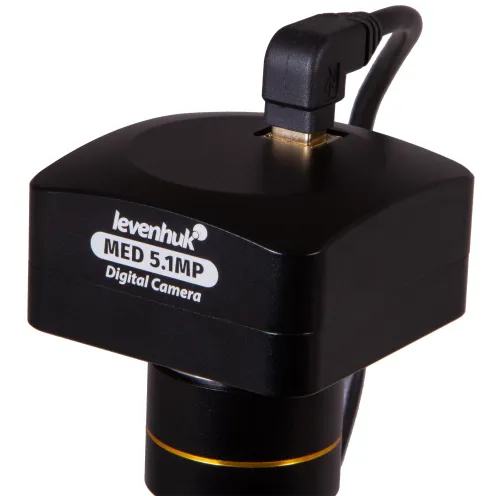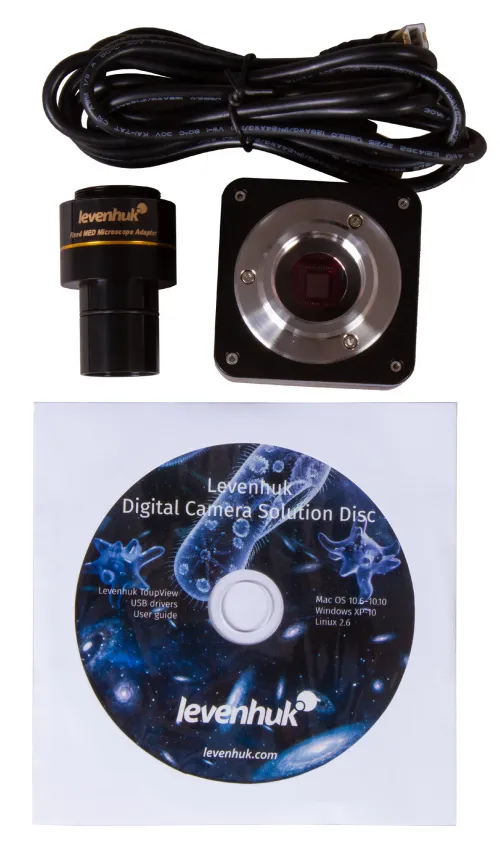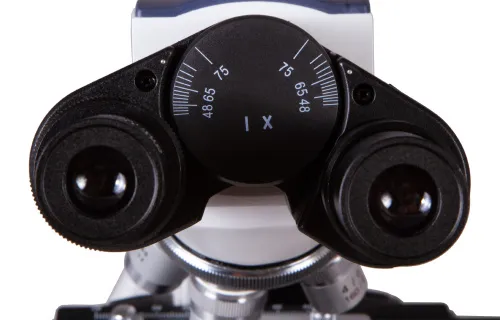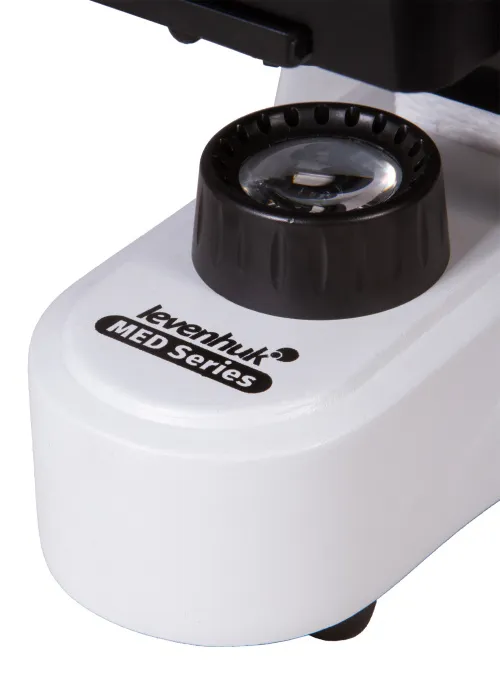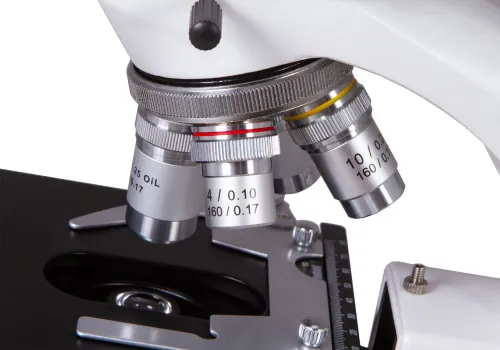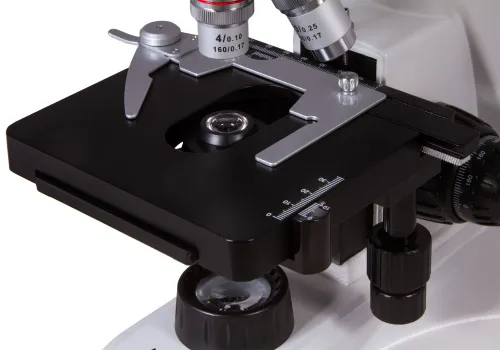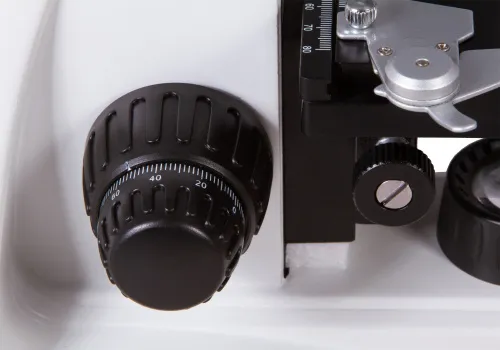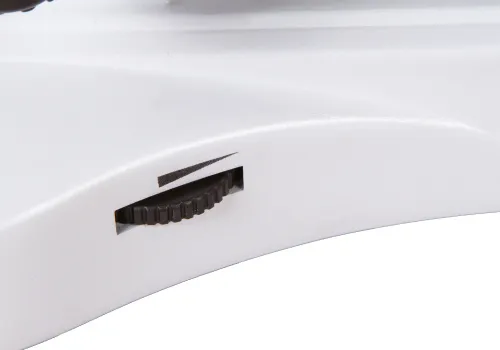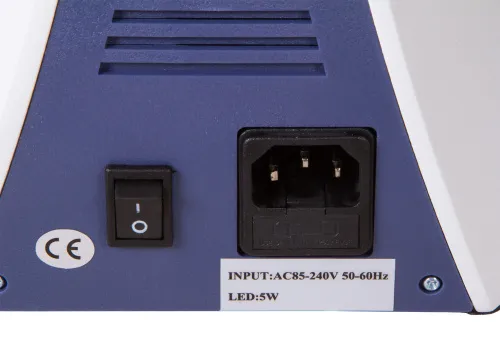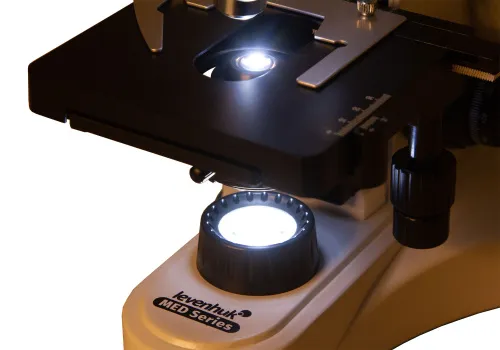Levenhuk MED D10T Digital Trinocular Microscope
Magnification: 40–1000x. Trinocular head, 5.1MP digital camera, achromatic objective lenses, and an Abbe condenser with an iris diaphragm, and a filter holder
| Product ID | 73986 |
| Brand | Levenhuk, Inc., USA |
| Warranty | lifetime |
| EAN | 5905555004884 |
| Package size (LxWxH) | 47x38x24 cm |
| Shipping Weight | 5.8 kg |
Levenhuk MED D10T Digital Microscope is a classic trinocular model with a digital camera in the kit. It is a great assistant in studying the micro world at magnifications in a range from 40x to 1,000x and recording observations in photo- or video mode. The microscope is suitable for holding lectures and seminars, conducting professional biological, clinical and diagnostic research as well as research in various scientific fields. The achromatic microscope optics is excellent for high-precision work with specimens.
A practical rotatable head
The trinocular head consists of a binocular visual part (it is intended for observations) and an ocular tube (for installing a digital camera in it). Due to that, you can study a specimen and transmit an image to an external screen simultaneously. This microscope design makes it a perfect choice for group research, when several people observe the same specimen. A visual part has 30° inclination. It is convenient to use during lengthy observations and, moreover, it reduces tension on the neck muscles and shoulder girdle. What’s more, this head is 360° rotatable.
High-class optics
The revolving nosepiece is designed for four objective lenses. The kit includes objective lenses of various magnification; the 40x and 100x objective lenses are equipped with spring-loaded frames for protecting the optics from accidental damage. A 100x objective lens is suitable for observations using oil immersion (a bottle with immersion oil is included in the kit). Wide-field eyepieces provide a good view and provide 10x magnification. All of the optical elements of the microscopes have an anti-fungal coating.
Digital capabilities
The 5.1MP digital camera is installed in the vertical ocular tube of the microscope. The camera can work in a photo and video mode. The camera is connected to a computer with a pre-installed image processing software (a software CD and USB cable are included in the kit). The camera makes working in a laboratory easier and more practical for an explorer: there is no need to strain your eyes when observing slides through eyepieces, as everything can be seen on a computer screen. This special program allows for the simple processing of photos and videos, setting up shooting parameters, and saving data for further work. The software allows for adjusting the size, image brightness and contrast, exposure time, calibrating a camera and objective lenses as well as measuring specimens or structures (several measurement units are available). High image quality allows for using them for professional research.
Convenient work with microscope slides
A stage is moveable along two axes, and it comes with a mechanical scale. The microscope lighting system is located underneath. It consists of a bright 5W LED light and an Abbe condenser with an iris diaphragm and filter holder (three light filters are included). The light is powered by an AC supply. The illumination system also features a brightness adjustment. Coarse and fine focusing adjustments are used for sharpness adjustment.
Features:
- Laboratory microscope with 40–1000x magnification
- 360° rotatable trinocular head, inclined at 30°
- Achromatic optics with an anti-fungal coating
- Lower 5W LED light with brightness adjustment
- Powered by an AC power supply
- 5.1MP digital camera is included in the kit
The kit includes:
- Microscope base with a stand
- 360° rotatable trinocular head
- Achromatic objective lenses: 4х, 10х, 40xs, 100хs (oil) with an anti-fungal coating
- Wide-field eyepieces: WF10x/18mm with an anti-fungal coating (2 pcs)
- Abbe condenser N.A. 1.25 with an iris diaphragm and a filter holder
- Filters: blue, green, yellow
- Bottle of immersion oil
- Fuse (2 pcs)
- Power cord for microscope
- Dust cover
- 5.1MP digital camera
- Camera adapter
- USB cable for connecting and powering camera
- Software CD and drivers
- User manual and lifetime warranty
Caution:
Please refer to the specifications table for the correct mains voltage and never attempt to plug a 110V device into 220V outlet and vice versa without using a converter. Remember that mains voltage in the U.S. and Canada is 110V and 220–240V in most European countries.
Some things you can see under a microscope:





Levenhuk MED D10T Digital Trinocular Microscope is also compatible with other Levenhuk digital cameras (additional cameras are purchased separately). Levenhuk cameras are installed in the eyepiece tube instead of an eyepiece. This microscope is also compatible with any other digital microscope cameras.
| Product ID | 73986 |
| Brand | Levenhuk, Inc., USA |
| Warranty | lifetime |
| EAN | 5905555004884 |
| Package size (LxWxH) | 47x38x24 cm |
| Shipping Weight | 5.8 kg |
| Type | biological, light/optical, digital |
| Microscope head type | trinocular |
| Optics material | optical glass with anti-fungal coating |
| Head | 360 ° rotatable |
| Head inclination angle | 30 ° |
| Magnification, x | 40 — 1000 |
| Eyepiece tube diameter, mm | 23.2 |
| Eyepieces | WF10x/18mm (2 pcs.) |
| Objectives | achromatic: 4x, 10x, 40xs, 100xs (oil immersion) |
| Revolving nosepiece | for 4 objectives |
| Interpupillary distance, mm | 48 — 75 |
| Stage, mm | 125х130 |
| Stage moving range, mm | 70/50 (movement in horizontal (X and Y) directions) |
| Coarse focusing travel, mm | 21 |
| Stage features | mechanical double-layer |
| Eyepiece diopter adjustment, diopters | ±5 |
| Condenser | Abbe N.A. 1.25 with an iris diaphragm and filter holder |
| Diaphragm | iris |
| Focus | coaxial, coarse (30mm) and fine (0.002mm) |
| Body | metal |
| Illumination | LED |
| Brightness adjustment | ✓ |
| Power supply | 100–240V |
| Light source type | 5W |
| Light filters | blue, green, yellow |
| User level | experienced users, professionals |
| Assembly and installation difficulty level | complicated |
| Application | laboratory/medical |
| Illumination location | lower |
| Research method | bright field |
| Digital camera included | ✓ |
| Pouch/case/bag in set | dust cover |
| Maximum resolution | 2048x1536 |
| Megapixels | 5.1 |
| Sensor element | 1/2.5" |
| Pixel size, μm | 2.2x2.2 |
| Video recording | yes |
| Image format | *.jpg, *.bmp, *.png, *.tif and others |
| Video format | output: *.wmv, *.avi, *.h264 (Windows 8 and later), *h265 (Windows 10 and later) |
| Spectral range, nm | 380–650 |
| White balance | automatic, manual |
| Exposure control | 0.294–2000μs |
| Sensitivity, V/lux-sec@550nm | 0.53 |
| Frame rate | 7@2592x1944 27@1280x960 90@640x480 |
| Dynamic range, dB | 66 |
| Usage location | the third 23.2mm ocular tube of the microscope |
| Software, drivers | LevenhukLite |
| Programmable options | brightness, image size, shutter time |
| Output | USB 2.0 |
| System requirements | Windows 8/10/11 (32bit and 64bit), Mac OS X, Linux, up to 2.8GHz Intel Core 2 or higher, minimum 2GB RAM, USB 2.0 port, CD-ROM |
and downloads
We have gathered answers to the most frequently asked questions to help you sort things out
Find out why studying eyes under a microscope is entertaining; how insects’ and arachnids’ eyes differ and what the best way is to observe such an interesting specimen
Read this review to learn how to observe human hair, what different hair looks like under a microscope and what magnification is required for observations
Learn what a numerical aperture is and how to choose a suitable objective lens for your microscope here
Learn what a spider looks like under microscope, when the best time is to take photos of it, how to study it properly at magnification and more interesting facts about observing insects and arachnids
This review for beginner explorers of the micro world introduces you to the optical, illuminating and mechanical parts of a microscope and their functions
Short article about Paramecium caudatum - a microorganism that is interesting to observe through any microscope
thanks for your query.
We expect this microscope to arrive in stock around 30/10/2022.
Is there any additional information you might need?

